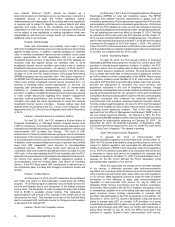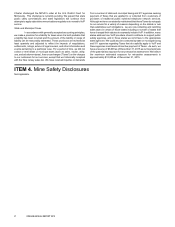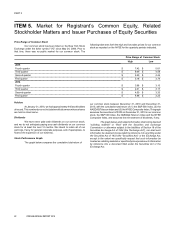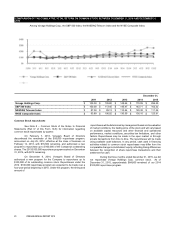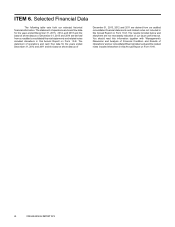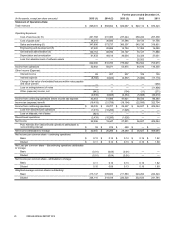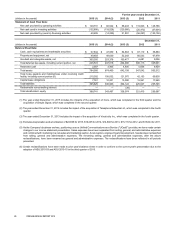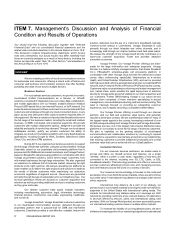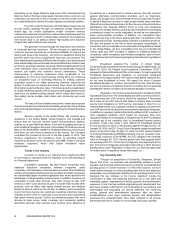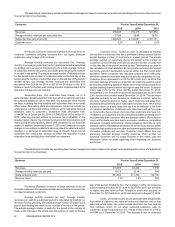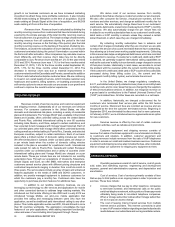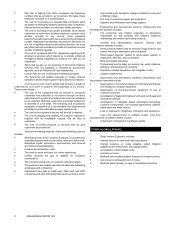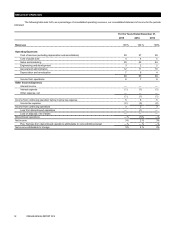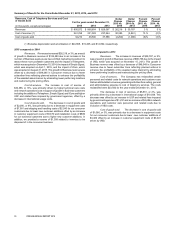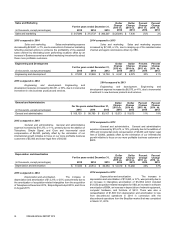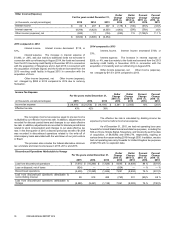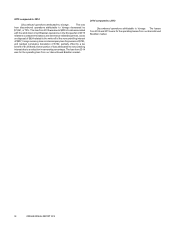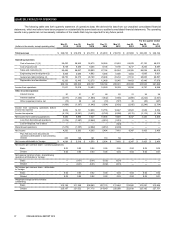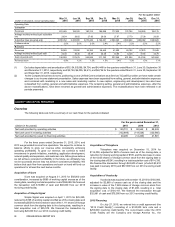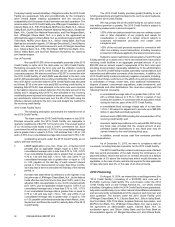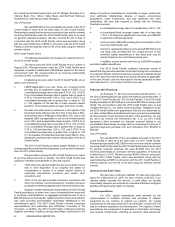Vonage 2015 Annual Report Download - page 36
Download and view the complete annual report
Please find page 36 of the 2015 Vonage annual report below. You can navigate through the pages in the report by either clicking on the pages listed below, or by using the keyword search tool below to find specific information within the annual report.
30 VONAGE ANNUAL REPORT 2015
growth in our business customers as we have increased marketing
investment to attract these more profitable customers. It also includes
48,920 seats existing at Telesphere at the time of acquisition, 35,256
seats existing at Simple Signal at the time of acquisition, and 86,309
seats existing at iCore at the time of acquisition.
Revenue churn. Revenue churn is calculated by dividing the
monthly recurring revenue from customers that have terminated during
a period by the simple average of the total monthly recurring revenue
from all customers in a given period. The simple average of total monthly
recurring revenue from all customers during the period is the total
monthly recurring revenue on the first day of the period, plus the total
monthly recurring revenue on the last day of the period, divided by two.
Terminations, as used in the calculation of churn statistics, do not include
customers terminated during the period if termination occurred within
the first month after activation. Other companies may calculate revenue
churn differently, and their revenue churn data may not be directly
comparable to ours. Revenue churn was flat at 1.2% for the year ended
2015 and 2014. Revenue churn was 1.1% for the three months ended
December 31, 2015, 1.3% for the three months ended September 30,
2015, 1.5% for the three months ended December 31, 2014. The
decrease in revenue churn was due to material improvements in
customer retention within Essentials and Premier, as well as the addition
of iCore's mid-market and enterprise customer base. We are continuing
to invest in our overall quality of service, which includes customer care
headcount and systems, billing systems, on-boarding processes and
self-service options to ensure we scale our processes to our growth and
continue to improve the overall customer experience.
OPERATING REVENUES
Revenues consist of services revenue and customer equipment
and shipping revenue. Substantially all of our revenues are services
revenue. For consumer customers in the United States, we offer
domestic and international rate plans, including a variety of residential
plans and mobile plans. The “Vonage World” plan, available in the United
States and Canada, offers unlimited calling across the United States
and Puerto Rico, unlimited international calling to over 60 countries
including India, Mexico, and China, subject to certain restrictions, and
free voicemail to text messages with Vonage Visual Voicemail. Each of
our unlimited plans other than Vonage World offers unlimited domestic
calling as well as unlimited calling to Puerto Rico, Canada, and selected
European countries, subject to certain restrictions. Each of our basic
plans offers a limited number of domestic calling minutes per month.
We offer similar plans in Canada. Under our basic plans, we charge on
a per minute basis when the number of domestic calling minutes
included in the plan is exceeded for a particular month. International
calls (except for calls to Puerto Rico, Canada and certain European
countries under our unlimited plans and a variety of countries under
international calling plans and Vonage World) are charged on a per
minute basis. These per minute fees are not included in our monthly
subscription fees. Through our acquisitions of Vocalocity, Telesphere,
Simple Signal, and iCore, we offer SMB, mid-market, and enterprise
customers several service plans with different pricing structures and
contractual requirements ranging in duration from month-to-month to
three years. The service plans include an array of basic and enhanced
features applicable to the needs of SMB and SOHO customers. In
addition, we provide managed equipment to business customers for
which the customers pay a monthly fee. Customers also have the
opportunity to purchase premium features for additional fees.
In addition to our landline telephony business, we are
leveraging our technology to offer services and applications for mobile
and other connected devices to address large existing markets. We
introduced our first mobile offering in late 2009 and in early 2012 we
introduced Vonage Mobile, our all-in-one mobile application that
provides free calling and messaging between users who have the
application, as well as traditional paid international calling to any other
phone. This mobile application works over WiFi, 3G and 4G and in more
than 90 countries worldwide. The application consolidates the best
features of our prior applications, while adding important functionality,
value and ease of use including direct payment through iTunes.
We derive most of our services revenue from monthly
subscription fees that we charge our customers under our service plans.
We also offer consumer fax service, virtual phone numbers, toll free
numbers and other services, and charge an additional monthly fee for
each service. We automatically charge these fees to our customers’
credit cards, debit cards, or electronic check payments (“ECP”), monthly
in advance. We also automatically charge the per minute fees not
included in our monthly subscription fees to our customers’ credit cards,
debit cards or ECP monthly in arrears unless they exceed a certain
dollar threshold, in which case they are charged immediately.
By collecting monthly subscription fees in advance and
certain other charges immediately after they are incurred, we are able
to reduce the amount of accounts receivable that we have outstanding,
thus allowing us to have lower working capital requirements. Collecting
in this manner also helps us mitigate bad debt losses, which are recorded
as a reduction to revenue. If a customer’s credit card, debit card or ECP
is declined, we generally suspend international calling capabilities as
well as the customer’s ability to incur domestic usage charges in excess
of their plan minutes. Historically, in most cases, we are able to correct
the problem with the customer within the current monthly billing cycle.
If the customer’s credit card, debit card or ECP could not be successfully
processed during three billing cycles (i.e., the current and two
subsequent monthly billing cycles), we terminate the account.
In the United States, we charge regulatory, compliance,
E-911, and intellectual property-related recovery fees on a monthly basis
to defray costs, and to cover taxes that we are charged by the suppliers
of telecommunications services. In addition, we recognize revenue on
a gross basis for contributions to the Federal Universal Service Fund
(“USF”) and related fees. All other taxes are recorded on a net basis.
In addition, historically, we charged a disconnect fee for
customers who terminated their service plan within the first twelve
months of service. Disconnect fees are recorded as revenue and are
recognized at the time the customer terminates service. Beginning in
September 2010, we eliminated the disconnect fee for new customers.
In February of 2012, we re-introduced service agreements as an option
for new customers.
Services revenue is offset by the cost of certain customer
acquisition activities, such as rebates and promotions.
Customer equipment and shipping revenue consists of
revenue from sales of customer equipment to our wholesalers or directly
to customers and retailers. In addition, customer equipment and
shipping revenues include revenues from the sale of VoIP telephones
in order to access our small and medium business services. Customer
equipment and shipping revenue also includes the fees, when collected,
that we charge our customers for shipping any equipment to them.
OPERATING EXPENSES
Operating expenses consist of cost of service, cost of goods
sold, sales and marketing expense, engineering and development
expense, general and administrative expense, and depreciation and
amortization.
Cost of services. Cost of services primarily consists of fees
that we pay to third parties on an ongoing basis in order to provide our
services. These fees include:
>Access charges that we pay to other telephone companies
to terminate domestic and international calls on the public
switched telephone network, with a portion of these payments
ultimately being made to incumbent telephone companies.
When a Vonage subscriber calls another Vonage subscriber,
we do not pay an access charge.
>The cost of leasing Internet transit services from multiple
Internet service providers. This Internet connectivity is used
to carry VoIP session initiation signaling and packetized audio
media between our subscribers and our regional data centers.


